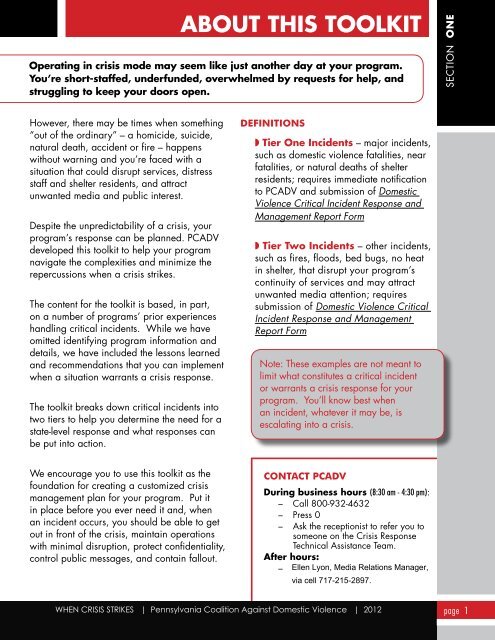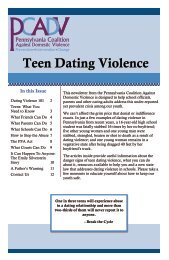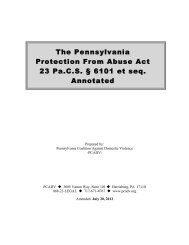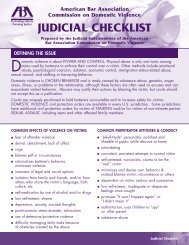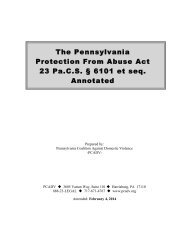Toolkit with Report Form - Pennsylvania Coalition Against Domestic ...
Toolkit with Report Form - Pennsylvania Coalition Against Domestic ...
Toolkit with Report Form - Pennsylvania Coalition Against Domestic ...
You also want an ePaper? Increase the reach of your titles
YUMPU automatically turns print PDFs into web optimized ePapers that Google loves.
ABOUT THIS TOOLKIT<br />
Operating in crisis mode may seem like just another day at your program.<br />
You’re short-staffed, underfunded, overwhelmed by requests for help, and<br />
struggling to keep your doors open.<br />
Section one<br />
However, there may be times when something<br />
“out of the ordinary” – a homicide, suicide,<br />
natural death, accident or fire – happens<br />
<strong>with</strong>out warning and you’re faced <strong>with</strong> a<br />
situation that could disrupt services, distress<br />
staff and shelter residents, and attract<br />
unwanted media and public interest.<br />
Despite the unpredictability of a crisis, your<br />
program’s response can be planned. PCADV<br />
developed this toolkit to help your program<br />
navigate the complexities and minimize the<br />
repercussions when a crisis strikes.<br />
The content for the toolkit is based, in part,<br />
on a number of programs’ prior experiences<br />
handling critical incidents. While we have<br />
omitted identifying program information and<br />
details, we have included the lessons learned<br />
and recommendations that you can implement<br />
when a situation warrants a crisis response.<br />
The toolkit breaks down critical incidents into<br />
two tiers to help you determine the need for a<br />
state-level response and what responses can<br />
be put into action.<br />
Definitions<br />
◗ Tier One Incidents – major incidents,<br />
such as domestic violence fatalities, near<br />
fatalities, or natural deaths of shelter<br />
residents; requires immediate notification<br />
to PCADV and submission of <strong>Domestic</strong><br />
Violence Critical Incident Response and<br />
Management <strong>Report</strong> <strong>Form</strong><br />
◗ Tier Two Incidents – other incidents,<br />
such as fires, floods, bed bugs, no heat<br />
in shelter, that disrupt your program’s<br />
continuity of services and may attract<br />
unwanted media attention; requires<br />
submission of <strong>Domestic</strong> Violence Critical<br />
Incident Response and Management<br />
<strong>Report</strong> <strong>Form</strong><br />
Note: These examples are not meant to<br />
limit what constitutes a critical incident<br />
or warrants a crisis response for your<br />
program. You’ll know best when<br />
an incident, whatever it may be, is<br />
escalating into a crisis.<br />
We encourage you to use this toolkit as the<br />
foundation for creating a customized crisis<br />
management plan for your program. Put it<br />
in place before you ever need it and, when<br />
an incident occurs, you should be able to get<br />
out in front of the crisis, maintain operations<br />
<strong>with</strong> minimal disruption, protect confidentiality,<br />
control public messages, and contain fallout.<br />
CONTACT PCADV<br />
During business hours (8:30 am - 4:30 pm):<br />
– Call 800-932-4632<br />
– Press 0<br />
– Ask the receptionist to refer you to<br />
someone on the Crisis Response<br />
Technical Assistance Team.<br />
After hours:<br />
– Call Judy Yupcavage,<br />
Director of Communications,<br />
via cell 717-514-3416<br />
When Crisis Strikes | <strong>Pennsylvania</strong> <strong>Coalition</strong> <strong>Against</strong> <strong>Domestic</strong> Violence | 2012<br />
page 1


